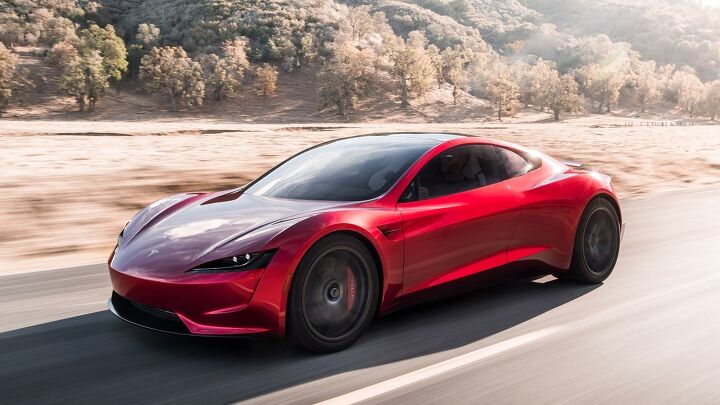Tesla's Big Gamble With Other People's Money

Unless you were living under a rock or on the moon late last week, you know Tesla introduced not one but two concepts on Thursday night — a Class 8 semi truck and a kinda-sorta-maybe Roadster (is it a roadster or a targa? It’ll only cost you a quarter mil to find out).
Since then, many corners of the internet have been yammering about the feasibility of Tesla’s plans, not to mention the wisdom of taking eyes off the very important ball that is the Model 3 in favor of two models that likely won’t appear until the next decade.
Tesla was founded in 2003, popping out an all-electric Roadster five years later. Costing $109,000, it went on to sell about 2,500 units during its production run, which ended when its contract with Lotus, which supplied “gliders” (motorless chassis and bodies), expired in 2011.
Chief Twitterer and CEO Elon Musk promised another model after the Roadster, which showed up in the form of the Model S midway through 2012. Sales have been nothing to sneeze at, nearly cresting 30,000 units during the calendar year of 2016. That’s a sum nearly eightfold compared to the number of XJs Jag managed to shift that same year. Heck, it’s more than 10,000 units greater than the total S-Classes sold by Mercedes-Benz.
The thing is, of course, that those manufacturers have many other models with which to make coin. Tesla does not. One of the ways a startup company (there is a significant argument to be made that Tesla is no longer a startup) can keep afloat is through rounds of funding, which can take any number of forms.
On June 29, 2010, Tesla launched its IPO on NASDAQ, when 13,300,000 shares of common stock was issued to the public at a price of US$17.00 per share. The IPO raised US$226 million. As I type this, Tesla stock sits at US$315.00 per share. It nearly touched US$400 in September. Launching an IPO, of course, suddenly means one’s company is no longer privately held, but it does provide an infusion of cash.
Tesla has now figured out a way to raise funds without giving up any part of the company: take deposits on cars that don’t exist based on promises that often skate the bounds of reality. When the company opened deposits on the Model 3, they hoovered up cash at the rate MC Hammer used to spend it. According to Musk, based on a press briefing this past July, over half a million people have now thrown down $1,000 each to reserve a Model 3, meaning Tesla has potentially brought in more than $500 million without the help of investors or by giving up any control of the company.
A similar tune was sung on Thursday, when it was revealed customers could reserve a Founders Series Roadster by plunking down the full $250,000 price tag. Tesla’s making 1,000 of them. Basic math teaches us that, if all 1,000 are reserved, a total of $250,000,000 will be deposited into Tesla’s coffers. That sum, it should be noted, exceeds the company’s initial IPO.
What do you think? Is all of this sustainable? Can Tesla possibly keep all of its promises? Will the house of cards fold like a cheap tent? Or will the company rise like a Phoenix and beat the big guns at their own game?
And – for fun – go look up John Phillip’s book God Wants You to Roll. Penned by one of the greatest automotive scribes to ever turn a phrase, it follows an advance fee fraud in which two out-of-work security guards took deposits on cars that didn’t exist, fleecing people across the nation to the eventual tune of $21 million. They assured their customers that refunds were available any time.
[Images: Tesla]

Matthew buys, sells, fixes, & races cars. As a human index of auto & auction knowledge, he is fond of making money and offering loud opinions.
More by Matthew Guy
Latest Car Reviews
Read moreLatest Product Reviews
Read moreRecent Comments
- 28-Cars-Later Actually Honda seems to have a brilliant mid to long term strategy which I can sum up in one word: tariffs.-BEV sales wane in the US, however they will sell in Europe (and sales will probably increase in Canada depending on how their government proceeds). -The EU Politburo and Canada concluded a trade treaty in 2017, and as of 2024 99% of all tariffs have been eliminated.-Trump in 2018 threatened a 25% tariff on European imported cars in the US and such rhetoric would likely come again should there be an actual election. -By building in Canada, product can still be sold in the US tariff free though USMCA/NAFTA II but it should allow Honda tariff free access to European markets.-However if the product were built in Marysville it could end up subject to tit-for-tat tariff depending on which junta is running the US in 2025. -Profitability on BEV has already been a variable to put it mildly, but to take on a 25% tariff to all of your product effectively shuts you out of that market.
- Lou_BC Actuality a very reasonable question.
- Lou_BC Peak rocket esthetic in those taillights (last photo)
- Lou_BC A pickup for most people would be a safe used car bet. Hard use/ abuse is relatively easy to spot and most people do not come close to using their full capabilities.
- Lorenzo People don't want EVs, they want inexpensive vehicles. EVs are not that. To paraphrase the philosopher Yogi Berra: If people don't wanna buy 'em, how you gonna stop 'em?




































Comments
Join the conversation
As someone mentioned a few days ago, if ttac really believed Tesla was doomed, a "Tesla Death Watch" would be in print. The stock value reinforces the perceived risk of betting against Tesla.
Speaking of Tesla, why has ttac not even mentioned something as relevant to motorists as Musk's Boring Company?